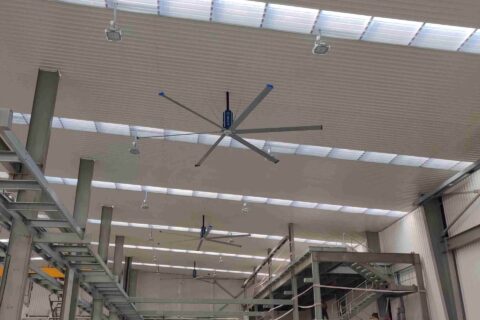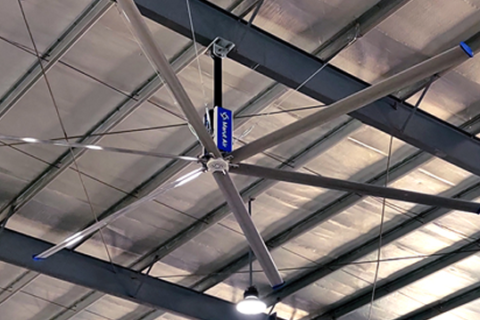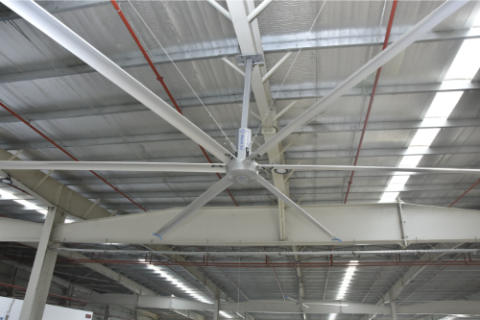A wide variety of industrial settings, such as production facilities, storage areas, warehouses, and factories, rely on cooling and ventilation systems to maintain a comfortable indoor temperature.
This guarantees the transmission of air with a temperature of 21–30 degrees Celsius, which is quite chilly. A specially designed network of air ducts allows for direct delivery of cooled air to the location of people or machinery. The plant workers’ comfort and working circumstances are greatly enhanced and all of this comes at 10% the cost of HVAC Systems
What is the best method for a factory cooling and Ventilation System?
One way that factories can keep their air cool is by installing an open-space cooling system, which makes use of evaporative cooling. To get cool air into the manufacturing space, it uses this in conjunction with an innovative, lightweight, insulated air duct system. Over a wide range of industries, this tried-and-true strategy has improved factory working conditions by making them cooler, more comfortable, and safer.
The factory cooling and ventilation system provides a refreshing change of air. The outside weather has an impact on the open-space cooling system’s air supply performance. It can draw in air from the outside and, depending on the humidity level, lower the temperature by a possible 10 degrees Celsius. The general rule is that cooling performance improves when outdoor circumstances are both hot and dry.
You can also read: How To Cool Your Factory With HVLS Fan?
Why Factory Cooling and Ventilation Are Crucial?
Here is why factory cooling and ventilation are crucial:
- Prevents heat stress: Industrial equipment and processes are notorious for generating excessive amounts of heat, leading to hazardous situations like heat stress, resulting in fatigue, dizziness, or even death. Cooling and ventilation systems prevent overheating.
- Improves air quality: Ventilation dilutes and removes particulate matter, fumes, and gasses that can dilute air quality and increase chances of developing respiratory illnesses and other health problems while performing work tasks.
- Regulates humidity: Ventilation contributes to the control of high humidity that can lead to mold growth, bacteria, and condensation which could ruin equipment and impair employee health.
- Increases employee attention span: A comfortable, cool and clean environment decreases worker fatigue and increases focus, thereby increasing productivity.
- Protects equipment: Proper temperature and humidity levels within an environment prevent malfunctioning and corrosion in equipment caused by heat and moisture, for consistent and efficient operation.
- Reduced energy costs: If designed well enough, a ventilation system decreased the need of artificial heating and cooling factors which leads to lower energy costs.
What are the Key Components of a Factory Cooling and Ventilation System?
Some of the key components of a factory cooling and ventilation system include:
Cooling Components
- Compressor: Compresses refrigerant gas, raising its pressure and temperature.
- Evaporator: The liquid refrigerant picks up heat energy from the air inside the building, causing the air temperature in the factory space to cool.
- Condenser: Rejects heat from the refrigerant back to the outside air and converts it back to a liquid refrigerant.
- Expansion Valve: Controls the flow of refrigerant into the evaporator.
Ventilation and Air Distribution Components
- Air Handler (AHU): A central unit that contains a blower fan to move air through the system.
- Ductwork: The channels that transport conditioned air throughout the factory.
- Filters: Remove dust, pollen, and other contaminants from the air to clean the air and protect the system.
- Exhaust Fans and Inlets: Work together to exhaust stale air out and bring fresh air in from the outside.
How does this system guarantee a supply of pure air?
To guarantee that only clean air is provided, the factory cooling and ventilation system incorporates air filtration machines. Depending on the needs of the application, it can adapt to the majority of filtration efficiencies and is compatible with a broad range of fine, coarse, and HEPA filters.
Why Should You Consider Ventilation Systems?
The open space cooler uses very little power, and nearly all of it is utilized by the air distribution system to move the cooled air around. As a result, evaporative heat exchange can use 10% less electricity than air conditioning. Customers can drastically reduce their energy bills by switching to the Open Space Cooling system from their old HVAC system.
Points to consider before getting cooling system
We know about the fact that each factory is unique. Some important points to consider before getting a Factory Cooling and Ventilation System from Marut Air are operations flow, facility layout, and worker/equipment placement.
To that end, Marut Air offers a no-cost expert consulting and design service to make sure your Open cooling system is tailor-made to get the cold air where it needs to go.
Application of ventilation systems
A wide variety of other industrial sectors can also benefit from these systems. Some of the industries where it is most often deployed are:
- Beverages
- Automobile Industries
- Plastic and Paper Packaging
- Pharmaceuticals
- Food
- Clothing and personal care
The factory cooling and ventilation system by Marut Air is applicable to many other industries and it can benefit your industry too. Speak to an expert to understand the specific applications for your industry today. To learn more about its practical uses in your field, consult us right now.
Don’t Forgot to check: How To Reduce Temperature In Factory?
FAQs About Factory Cooling and Ventilation Systems
Question 1. Why is proper ventilation important in factories?
Answer. It is crucial to have proper vetialation in factories to ensure worker safety, health and productivity by removing airborne contaminants like dust and fumes, controlling temperature and humidity and supplying fresh air.
Question 2. What are the key benefits of factory cooling and ventilation solutions?
Answer. Some of the key benefits of factory cooling and ventilation solutions include improving working conditions, enhancing productivity and lowering operational costs.
Question 3. What types of cooling and ventilation systems does Marut Air provide?
Answer. Marut Air provides various types of cooling and ventilation systems including High Volume Low-Speed (HVLS) fans, industrial coolers and exhaust fans.
Question 4. What industries can benefit from cooling and ventilation solutions?
Answer. Industries that benefit from cooling and ventilation solutions include manufacturing, food and beverage, healthcare, data centers and automotive.





